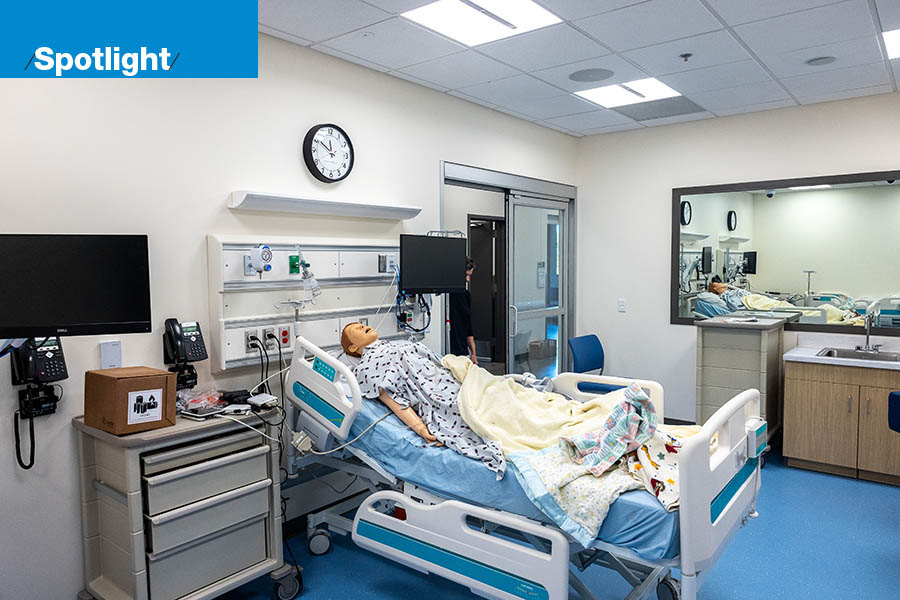The nursing-educator shortage is an old story with growing consequences. Can Oregon’s colleges and lawmakers finally solve the problem?
Becoming a nurse was a dream for Cesa Summer. At 46 years old, she was excited to be heading down a proven career path that promised variety, personal fulfillment and finally some financial stability.
“I got tired of being poor,” she says with a laugh.
Though she was highly motivated, Summer’s dream nearly derailed at the last minute. It wasn’t failing grades, illness or outside pressures that put her graduation from Portland Community College’s rigorous two-year nursing program in jeopardy.

The threat to Summer’s diploma was coming from inside the house.
In April 2023, shortly before Summer was set to graduate, Lisa Sanchez-Navarro — the director of Portland Community College’s program — resigned her position. That started the clock ticking: Administrators had just 15 days to find a new director and have them approved by the Oregon State Board of Nursing (OSBN) — or shutter the program.
After a lot of shuffling and searching, and an extra 15-day extension, PCC administrators hired Cynthia Backer as interim program Dean of Nursing. With an approved director in place, Summer and her cohort of new nurses could get their diplomas and start their nursing careers.
“The Oregon State Board of Nursing works closely with all of the colleges,” says Janeen Hull, PCC’s dean of academic & career pathways for healthcare & emergency professions. “They would never leave students hanging.”
Yet nursing students, nursing educators, hospitals and ultimately everyone seeking health care in Oregon are all in danger of being left hanging. Nurses are in desperately short supply, but fully qualified nurse educators are really hard to find. In fact, though her résumé is long, even Backer does not meet the full qualifications set by OSBN to become a permanent hire. Finding a permanent candidate to meet those full standards will be challenging.
“The pool of qualified nurses who want to work in education is small,” Hull admits.
The nursing shortage, nursing-educator shortage and connection between the two is old news. The American Association of Colleges of Nursing (AACN) has been highlighting the issue for over two decades, according to an article in American Nurse. Written by Susan Bakewell-Sachs, OHSU School of Nursing dean, along with two other contributors, the article calls the problem behind the nurse-faculty shortage a “matter of great and growing concern.”
A sticky web of interconnected issues — burnout, lack of clinical and lab space, uncompetitive pay for nurse educators, and a fair dose of institutional misogyny — drives this crisis. The COVID pandemic accelerated the pace. And while this is a nationwide problem, Oregon has been hit particularly hard. The state produces the third-fewest nursing school graduates per capita as compared to the rest of the country, according to a study by the Oregon Longitudinal Data Collaborative (OLDC).
Statewide, stakeholders hunt for coordinated solutions, but the prognosis is unknown. The nursing and nursing-educator crisis has festered for a long time. Can this finally be the moment of change?
It is not that people do not want to become nurses. Just like Summer, plenty of good candidates dream of starting down this path. For this year’s fall class, Portland Community College alone had 400 well-qualified applicants to their program, according to Hull. The program, however, could only accommodate 32 of them — that is, 8% of total applicants.
Numbers across the state are a little better, but not much. The OLDC study found that 6,800 qualified people applied to programs in 2020, but only 23% were accepted. On the national level, there were 91,038 qualified nursing applications left on the table in 2021.
The fact that most registered nursing programs in Oregon have enough qualified applications and regional jobs to double enrollment is heartening, even as the profession evolves into something more complex. The job has certainly changed from when Backer was in school: “We were trained to give back rubs, help people eat and do bed baths,” she says. “People go into nursing for heartfelt reasons, but there has definitely been a change in expectations.”
Expectations for nurse educators have shifted as well. The job demands they keep up with an ever-expanding body of health care knowledge, even as textbooks lag behind.
“You can’t just teach to the book,” says Backer. “Teachers need the most current, online resources and access to real world examples.”

They also need to know how to teach. That means successfully communicating information to a diverse set of students with different learning styles. (Nursing students often need a fair bit of hand holding, Summer says. “We were neurotic,” she says, “and in a state of panic all the time!”)
But anxious students and high expectations are just add-ons to the root causes of the nurse/nursing educator shortage. The biggest problems are a lack of clinical space where students practice and a huge disparity in the pay a teacher can make as compared to a nurse working in the field.
The situation is no better at private colleges and universities.
“We absolutely do not have enough nurse educators,” Dean Casey Shillam, School of Nursing & Health Innovations, University of Portland, says.
Even if there were an abundance of educators, the lack of clinical space squeezes the nursing pipeline to a drip. These clinical placements are required for all students. To get them, the schools must foster individual relationships with healthcare placement sites. This forces a competition between the programs where the students are the losers. The longitudinal study found that 95 percent of nursing programs had an individual or cohort denied placement from 2016 to 2020.
Securing clinical space has always been difficult. The pandemic made it worse. “Placements in off-campus professional practice, hospitals, and community-based, long-term care has all diminished because the health systems are not functioning,” says Shillam. “They have no capacity to take students.”
But perhaps the biggest barrier to becoming a nurse educator is money. Low nursing educator pay is the standard across the nation. According to the latest Nurse Salary Research Report issued by Nurse.com, the median salary across advanced practice registered nurse roles is $120,000. By contrast, AACN reported in March 2022 that the average salary for a master’s-prepared professor in schools of nursing is $87,325.
Payment structures widen the disparity. Nurses are paid hourly; nursing educators draw a salary. That means any extra work outside the contract — like prepping courses, attending orientations or reassuring anxious students — is unpaid.
Oregon has one of the largest pay gaps between nursing faculty and registered nurses, according to the OLDC study. This makes it easier to lure even the most dedicated faculty away.
“Even if nurses want to get into academic nursing, the health systems are so desperate for clinicians that they are offering nurses their dream jobs, and I’m losing faculty,” laments Dean Shillam. She reports losing four faculty members this year alone to positions that she admits make her a bit envious. “They are landing fully remote telehealth jobs or working just three days a week in patient intake, receiving full benefits, and making one and a half times more.”
Why is nursing-educator pay so low, particularly when compared with what medical educators — the professionals who teach doctors — make?
Medical education is supplemented by Medicare. Nursing is not, answers Dean Shillam. And why is that? “Because physicians have more influence in Medicare funding decisions and nursing doesn’t have the same level of influence and impact in how nursing education could be equitably funded.”
So the nursing-education system is built on the underlying expectation of unpaid labor. Shillam is not ready to call this situation straight-up misogyny but will admit that “historically, physicians were predominantly male and have driven these policies, whereas nurses were predominantly and still are majority female.”
Structural inequities aside, Oregon’s nursing schools and legislators are working to find a solution.
PCC is expanding its programs, adding options like Certified Nursing Assistant and Licensed Practical Nurse to its course list. These easier-to-
obtain certifications make nursing accessible to students who need to start their careers sooner. The move will hopefully ease labor shortages while giving students a stepping stone to the next level.
PCC is also opening a brand-new, state-of-the-art nursing education simulation lab at its Sylvania campus. This larger space, filled with sophisticated equipment like simulation mannequins, will make room for another cohort of students, bumping up PCC’s class size from 32 to 40.
Oregon Health & Science University is hard at work implementing its 30-30-30 plan. Funded in March of last year, the $45 million investment aims to increase the number of clinicians graduated by 30% and increase student diversity by 30% by the year 2030. The money includes an extra $20 million per year to expand class sizes and a one-time $25 million to kick-start the OHSU Opportunity Fund. This money will go to tuition assistance, loan repayment and other resources needed to recruit and retain a more diverse class of learners.
“We have nurses who are interested in advanced degrees and thinking about taking education coursework that would allow them to teach,” says OHSU’s School of Nursing Dean Bakewell-Sachs. “The 30-30-30 plan is seeking to meet workforce needs for nurses and other professions and seeking to establish a long-term solution.”
The Opportunity Fund, according to Bakewell-Sachs, is about “building the workforce of the future. We want to align workforces to mirror society. If we increase the diversity of our students, we want to have faculty to align with that as well.”
OHSU also established the Oregon Nursing Education Academy to expand the ranks of preceptors and clinical nursing faculty. This program hopes to train a total of 63 faculty and 92 preceptors from Oregon, Idaho, Washington and Alaska by the fall of 2026. The program is designed for nurses who already have a bachelor’s degree or higher in nursing.
Nurses that graduate with an associate’s degree from community colleges are already pretty well incented to get their bachelor’s degree. “That’s where the upward mobility is,” explains Hull. “Certain hospitals only want to hire nurses with a bachelor’s.”
Summer, the recent graduate from PCC, is already planning for hers. She’ll start working as a nurse in telemetry while taking OHSU bachelor’s-level classes online.
The recently passed SB 523 aims to make it easier and less costly for future community college graduates to get their bachelor’s, particularly for students in rural areas. “The bill tries to capture students who wouldn’t continue on or [would] do it through an out-of-state, for-profit option,” explains John Wykoff, deputy director of the Oregon Community College Association. “This cost-effective option should be more attractive to students.” The program could also help keep rural students in rural communities, where the need is greater.
But the bill does not wow PCC’s Hull. “I haven’t explored what SB 523 would mean for us,” she says. “I can’t even find enough instructors for our associate’s program.”
None of these efforts, however, address the pay disparity between educators and practitioners. The OLDC study analysis found that increasing wages by $6,139 for nine-month nursing faculty would incent and entice instructors. The report stresses that schools should collaborate on pay increases statewide to avoid creating competition between programs.
Where that money would come from presents another issue. Proposed legislative action, HB 3323, would create a stipend for nurse educators. Hull was a bit more excited about this bill. “Washington state already does something like this. It could be a possible solution.” The bill, however, was still in committee when the House adjourned in June.
Backer at PCC suggests that some face-to-face recruiting with nurses could help sway them over to teaching. “I see nurses at hospitals that are so good with students,” she says. “We should seek these people out and show them why teaching is a worthy career. We need to advertise to them, let them know it can be fun.”
As far as finding more clinical space, Backer suggests looking for new opportunities outside of hospitals. “What about addiction clinics or homeless shelters? They have to be places where the student is getting nursing experience.”
While these are all good steps forward, fixing the nurse/nurse-educator shortage will be an uphill battle. Burnout among current nurses is extremely high. About 100,000 registered nurses left the workforce during the past two years due to stress, burnout and retirements, and another 610,388 reported an intent to leave by 2027, according to a study released by the National Council of State Boards of Nursing and reported by the American Hospital Association.
Perhaps this is because of a system that needs nurses yet undervalues their contributions.
“The system values doctors because hospitals can bill for their work,” Summer says. “They see nurses as a money-suck even though we are essential for patient care.”
Still, Summer holds a lot of admiration for the nurses who helped her along the way. She would like to teach eventually, saying it is on her long-term trajectory. But she’s come across so many nurses suffering from compassion fatigue that she wonders.
“I chose nursing because I can keep learning. There are a lot of fields to go into, and you can’t do bedside forever,” she says. “Teaching would be a great trajectory. They just need to be paid more.”
Click here to subscribe to Oregon Business.








